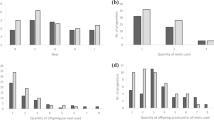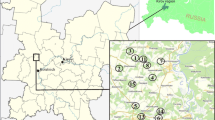Abstract
We demonstrate the potential of a set of novel microsatellite markers to investigate kin structure and population genetics in the Northern Wheatear (Oenanthe oenanthe). In this study, based on 242 individuals from a population in Rhineland-Palatinate (Germany), we found that 26% of the offspring in 46% of the broods were sired by other males than the social fathers. We tested different hypotheses why males engage in extrapair copulations and found that almost all identified genetic fathers originated from directly neighbouring territories. Additionally, we detected 2 out of 134 offspring in two broods that could not be assigned to their putative mother and thus were probably the result of intraspecific brood parasitism.



Similar content being viewed by others
References
Akςay E, Roughgarden J (2007) Extrapair paternity in birds: review of the genetic benefits. Evol Ecol Res 9:855–868
Arlt D, Part T (2007) Nonideal breeding habitat selection: a mismatch between preference and fitness. Ecology 88:792–801
Arlt D, Part T (2008) Post-breeding information gathering and breeding territory shifts in northern wheatears. J Anim Ecol 77:211–219
Belkhir K, Castric V, Bonhomme F (2002) IDENTIX, a software to test for relatedness in a population using permutation methods. Mol Ecol Notes 2:611–614
Birkhead TR, Møller AP (1992) Sperm competition in birds. Academic, London
Bouwman KM, Burke T, Komdeur J (2006) How female reed buntings benefit from extrapair mating behaviour: testing hypotheses through patterns of paternity in sequential broods. Mol Ecol 15:2589–2600
Bouwman KM, Van Dijk RE, Wijmenga JJ, Komdeur J (2007) Older male reed buntings are more successful at gaining extrapair fertilizations. Anim Behav 73:15–27
Buchman M, Helm B, Rothery P, Flinks H (2009) Auswirkungen von Spätbruten auf Mauser und Rückkehrrate bei einem Weitstreckenzieher, dem Steinschmätzer (Oenanthe oenanthe). Die Vogelwarte 47:125–133
Buchmann M (2001) Die Brutbiologie des Steinschmätzers (Oenanthe oenanthe) auf intensiv genutzen Flächen in Rheinland-Pfalz. Die Vogelwarte 41:1–17
Charmantier A, Blondel J, Perret P, Lambrechts MM (2004) Do extrapair paternities provide genetic benefits for female blue tits Parus caeruleus? J Avian Biol 35:524–532
Coltman DW, Pilkington JG, Smith JA, Pemberton JM (1999) Parasite-mediated selection against inbred soay sheep in a freeliving island population. Evolution 53:1259–1267
Crawley MJ (2007) The R book. Wiley, West Sussex
Currie DR, Burke T, Whitney RL, Thompson DBA (1998) Male and female behaviour and extrapair paternity in the wheatear. Anim Behav 55:689–703
Delingat J, Bairlein F, Hedenstrom A (2008) Obligatory barrier crossing and adaptive fuel management in migratory birds: the case of the Atlantic crossing in northern wheatears (Oenanthe oenanthe). Behav Ecol Sociobiol 62:1069–1078
Dietrich-Bischoff VD, Schmoll T, Winkel W, Krackow S, Lubjuhn T (2006) Extrapair paternity, offspring mortality and offspring sex ratio in the socially monogamous coal tit (Parus ater). Behav Ecol Sociobiol 60:563–571
Foerster K, Delhey K, Johnsen A, Lifjeld JT, Kempenaers B (2003) Females increase offspring heterozygosity and fitness through extrapair matings. Nature 425:714–717
Fossøy F, Johnsen A, Lifjeld JT (2007) Multiple genetic benefits of female promiscuity in a socially monogamous passerine. Evolution 62:145–156
Freeman S, Jackson WM (1990) Univariate metrics are not adequate to measure avian body size. Auk 107:69–74
Fridolfsson AK, Ellegren H (1999) A simple and universal method for molecular sexing of non-ratite birds. J Avian Biol 30:116–121
Garvin JC, Abroe B, Pedersen MC, Dunn PO, Whittingham LA (2006) Immune response of nestling warblers varies with extrapair paternity and temperature. Mol Ecol 15:3833–3840
Griffith SC (2000) A trade-off between reproduction and condition-dependent sexually selected ornament in the house sparrow Passer domesticus. Proc R Soc Lond B 267:1115–1119
Griffith SC, Immler S (2009) Female infidelity and genetic compatibility in birds: the role of the genetically loaded raffle in understanding the function of extrapair paternity. J Avian Biol 40:97–101
Griffith SC, Owens IP, Thuman KA (2002) Extra pair paternity in birds: a review of interspecific variation and adaptive function. Mol Ecol 11:2195–2212
Johnsen A, Andersen V, Sunding C, Lifjeld JT (2000) Female bluethroats enhance offspring immunocompetence through extrapair copulations. Nature 406:296–299
Kalinowski ST, Taper ML, Marshall TC (2007) Revising how the computer program CERVUS accomodates genotypic error increases success in paternity assignment. Mol Ecol 16:1099–1106
Kempenaers B, Congdon B, Boag P, Robertson RJ (1999) Extrapair paternity and egg hatchability in tree swallows: evidence for the genetic compatibility hypothesis? Behav Ecol 10:304–311
Komdeur J, Pen I (2002) Adaptive sex allocation in birds: the complexities of linking theory and practice. Philos Trans R Soc Lond B 357:373–380
Kudernatsch D, Weis-Dootz T, Segelbacher G (2009) Isolation of ten tetranucleotide microsatellite loci in the northern wheatear (Oenanthe oenanthe). Mol Ecol Ressour 9:542–543
Menzel H (1964) Die neue Brehm Bücherei—Der Steinschmätzer (Oenanthe oenanthe). Ziemsen, Wittenberg Lutherstadt
Miller SA, Dykes DD, Polesky HF (1988) A simple salting out procedure for extracting DNA from human nucleated cells. Nucleic Acids Res 16:1215
Møller AP, Ninni P (1998) Sperm competition and sexual selection: a meta-analysis of paternity studies in birds. Behav Ecol Sociobiol 43:345–358
Ockendon N, Griffith SC, Burke T (2009) Extrapair paternity in an insular population of house sparrows after the experimental introduction of individuals from the mainland. Behav Ecol 20:305–312
Perreault S, Lemon RE, Kuhnlein U (1997) Patterns and correlates of extrapair paternity in American redstarts (Setophaga ruticilla). Behav Ecol 8:612–621
Petrie M, Kempenaers B (1998) Extrapair paternity in birds: explaining variation between species and populations. Trends Ecol Evol 13:52–58
Queller DC, Goodnight KF (1989) Estimating relatedness using genetic markers. Evolution 43:258–275
R Development Core Team (2007) R: a language and environment for statistical computing. R Foundation for Statistical Computing, Vienna
Raymond M, Rousset F (1995) GENEPOP (Version 1.2): population genetics software for exact tests and ecumenicism. J Hered 86:248–249
Schulte-Hostedde AI, Zinner B, Millar JS, Hickling GJ (2005) Restitution of mass-size residuals: validating body condition indices. Ecology 86:155–163
Segelbacher G, Kabisch D, Stauss M, Tomiuk J (2005) Extrapair young despite strong pair bonds in the European nuthatch (Sitta europaea). J Ornithol 146:99–102
Seutin G, White BN, Boag PT (1991) Preservation of avian blood tissue samples for DNA analysis. Can J Zool 69:82–90
Sokal R, Rohlf FJ (1994) Biometry, 3rd edn. Freeman, New York
Stapleton MK, Kleven O, Lifjeld JT, Robertson RJ (2007) Female tree swallows (Tachycieneta bicolor) increase offspring heterozygosity through extrapair mating. Behav Ecol Sociobiol 16:1725–1733
Tregenza T, Wedel N (2000) Genetic compatibility, mate choice and patterns of parentage: invited review. Mol Ecol 9:1013–1027
Trivers RL, Willard DE (1973) Natural selection of parental ability to vary the sex ratio of offspring. Science 179:90–92
Westneat DF, Sherman PW, Morton ML (1990) The ecology and evolution of extrapair copulations in birds. In: Power DM (ed) Current ornithology. Plenum, New York, pp 331–369
Yasui Y (1998) The ‘genetic benefits’ of female multiple mating considered. Trends Ecol Evol 13:246–250
Yasui Y (2001) Female multiple mating as a genetic bet-hedging strategy when mate choice criteria are unreliable. Ecol Res 16:605–616
Author information
Authors and Affiliations
Corresponding author
Additional information
Communicated by F. Bairlein.
Appendix
Appendix
See Table 2.
Rights and permissions
About this article
Cite this article
Kudernatsch, D., Buchmann, M., Fiedler, W. et al. Extrapair paternity in a German population of the Northern Wheatear (Oenanthe oenanthe). J Ornithol 151, 491–498 (2010). https://doi.org/10.1007/s10336-009-0486-z
Received:
Revised:
Accepted:
Published:
Issue Date:
DOI: https://doi.org/10.1007/s10336-009-0486-z




